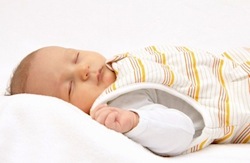As a first time parent I was overloaded with pamphlets telling me all the dos and don’ts for keeping my baby healthy and safe. It can be quite overwhelming when you’re trying to do the best you can and keep your precious little person safe.
Doing everything possible to reduce the risk of Sudden Unexpected Death of Infant (SUDI), also known as Sudden Infant Death Syndrome (SIDS) was one of my top priorities. I religiously made sure that I abided by the safe sleep practices check list which included ‘a firm well-fitted mattress’. Up until now this was a bit ambiguous as the appropriate ‘firmness’ was not specified. It was up to us as parents to determine what we considered to be ‘firm’.
A new standard, AS/NZS 8811.1:2013, has been introduced to specify a method for manufacturers to test the firmness of surfaces where an infant is reasonably expected to sleep. This includes mattresses in carrycots and portacots, and stroller liners. The standard is a result of a recent study which revealed an association between infant mortality and overly soft sleep surfaces being a risk factor for SUDI/SIDS. The study confirms that a firm mattress reduces the risk of an infant’s breathing being obstructed if they roll face down. Although we are told to sleep baby on their back with their face up, we all know that they don’t always stay in this position. An overly soft mattress could smother a baby whereas a firm mattress will allow there to be space between the mattress and the baby’s nose allowing them to breathe freely.
This new standard gives parent’s peace of mind that products with this certification have been approved to reduce the risk of SUDI/SIDS. Something that is so important.
The standard may still be hot off the press but phil&teds and Mountain Buggy have already had their products tested. In fact they embarked on testing as soon as they got wind of the standard as part of their commitment to safety. To make it easy for parents to choose products with the big tick, look out for the ‘Firm sleep surface approved’ tag on phil&teds and Mountain Buggy packaging and on their websites.
So the moral of the story is that although the soft mattress looks cosy, go for firm mattress, its much safer for your baby.
The New Zealand College of Midwives specifies the following safe sleep practices to ensure that your baby sleeps safe and sound:
- Place baby to sleep lying face up (on their back)
- Ensure baby’s face is clear and will stay clear (i.e. fitted sheets, tucked in blankets, firm mattress, snugly fitted mattress with no gaps for baby to roll into, no pillows or hats, and nothing around that could fall and cover their face)
- Provide a smokefree environment (during pregnancy and after birth)
- Give baby their own space to sleep (such as a cot, bassinet, wahakura or other types of ‘baby beds’)
- Keep baby in the same room as you for the first six months
- Regularly check on baby
- Breastfeed your baby if possible.
For more information on safety testing conducted by phil&teds visit http://philandteds.com/nz/Support/Testing or for Mountain Buggy visit http://mountainbuggy.com/en/certifications






Great to read about this standard. But why of why do you have a photo of a naked baby with loose bedding? Surely a safe swaddle or sleeping bag would send a much safer message to your readers.
Hi Louise, thanks for the feedback. It’s surprisingly hard to find stock images of babies sleeping safely but how’s the one I’ve added above?
Thanks!
Rochelle
It’s sleeping on a pillow! Not safe for a baby! Would you like me to send one to you? Drop me an email at louise@thesleepstore.co.nz
Ha ha! I had assumed it was a safe sleep thingy 😉 Thanks – will email!